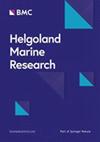Satellite observations of the effect of the “Godzilla El Niño” on the Tehuantepec upwelling system in the Mexican Pacific
4区 地球科学
Q2 Agricultural and Biological Sciences
引用次数: 4
Abstract
During 2015–2016, a strong El Niño, the “Godzilla El Niño,” which is similar to El Niño events that occurred in 1982/1983 and 1997/1998, occurred in the Pacific Ocean. In this paper, we report on the influence of the “Godzilla El Niño” on the sea surface temperature (SST) and chlorophyll-a (Chla) concentrations in the Tehuantepec upwelling system using satellite observation data. A time-series of the SST and Chla levels in a circular site with a diameter of approximately 54 km centered at the fixed position (15°N, 94.75°W) for the period from January 2003 to December 2016 was obtained using a Moderate Resolution Imaging Spectroradiometer. To estimate the vertical water velocity, a wind velocity time series was obtained from the Copernicus Marine Environment Monitoring Service to assess its variation over the period from January 2014 to December 2016. The results showed unusually high SSTs (> 28 °C) and atypically low Chla concentrations (< 0.1 mg m−3) in the domain of interest during the winter of 2015/2016. In the region of study, the SST in January 2016 was 5.13 °C higher than it had been in January of 2015, whereas the Chla concentration was 1.56 mg m−3 lower over this period. We found that the “Godzilla El Niño” impacted the Tehuantepec upwelling system in the following ways: (1) the wind and vertical water velocity during the winter of 2015/2016 were slightly higher than those observed during the winters of 2013/2014 and 2014/2015; (2) the coastal SST values were elevated during the winter of 2015/2016 compared to their levels during the previous two winters, revealing nutrient-poor water advection; and (3) the Chla concentrations during the 2015/2016 winter season were unusually low compared to their levels during the previous two winters. Our interpretation of these results is that in the Tehuantepec Gulf the wind was strong and induced vertical water velocities reaching up to 6 m day−1 during the “Godzilla El Niño” event (winter 2015/2016); however, the levels of Chla during this period were lower than they had been in previous years. In particular, the levels were lower than they had been during the previous winters. This suggests that, although the wind during the event favored strong upwelling, the water that was advected to the upper layer was nutrient poor.“哥斯拉Niño”对墨西哥太平洋特万特佩克上升流系统影响的卫星观测
在2015-2016年期间,太平洋发生了一次强厄尔尼诺Niño,即“哥斯拉厄尔尼诺Niño”,与1982/1983年和1997/1998年发生的厄尔尼诺Niño事件相似。本文利用卫星观测资料,报道了“哥斯拉Niño”对特万特佩克上升流系统海温(SST)和叶绿素a (Chla)浓度的影响。利用中分辨率成像光谱仪获得了2003年1月至2016年12月以固定位置(15°N, 94.75°W)为中心的直径约54 km的圆形站点的海温和Chla水平的时间序列。为了估算垂直水流速度,我们从哥白尼海洋环境监测服务获得了风速时间序列,以评估其在2014年1月至2016年12月期间的变化。结果显示,在2015/2016年冬季,研究区域的SSTs异常高(> 28°C), Chla浓度异常低(< 0.1 mg m - 3)。研究区2016年1月海表温度较2015年1月升高5.13°C, Chla浓度较2015年1月降低1.56 mg m−3。研究发现,“哥斯拉Niño”对特万特佩克上升流系统的影响主要表现在以下几个方面:(1)2015/2016冬季的风速和垂直流速略高于2013/2014和2014/2015冬季;(2)与前两个冬季相比,2015/2016年冬季沿海海表温度升高,表现为贫营养水平流;(3) 2015/2016年冬季Chla浓度较前两个冬季异常低。我们对这些结果的解释是,在“Godzilla El Niño”事件(2015/2016冬季)期间,在Tehuantepec海湾,风很强,诱导垂直水速度达到6 m day - 1;然而,在此期间,Chla的水平低于前几年。特别是,这一水平比前几个冬天都要低。这表明,尽管事件期间的风有利于强劲的上升流,但平流到上层的水营养贫乏。
本文章由计算机程序翻译,如有差异,请以英文原文为准。
求助全文
约1分钟内获得全文
求助全文
来源期刊

Helgoland Marine Research
地学-海洋学
自引率
0.00%
发文量
0
审稿时长
6-12 weeks
期刊介绍:
Helgoland Marine Research is an open access, peer reviewed journal, publishing original research as well as reviews on all aspects of marine and brackish water ecosystems, with a focus on how organisms survive in, and interact with, their environment.
The aim of Helgoland Marine Research is to publish work with a regional focus, but with clear global implications, or vice versa; research with global emphasis and regional ramifications. We are particularly interested in contributions that further our general understanding of how marine ecosystems work, and that concentrate on species’ interactions.
 求助内容:
求助内容: 应助结果提醒方式:
应助结果提醒方式:


